Tired of visiting the same old museums, finding yourself craning over tourists to get that perfect picture of the diminutive Mona Lisa only to find a better reproduction in the museum shop? Sure, museums have their big fans, and were else are you going to see a collection of static art that just, well, stands there for time immemorial? Museum alternatives abound, but what’s an art lover/museum hater to do?
Temporary, or ephemeral art has a now-you-see-it-then-you-don´t quality to it. It may be constructed for the viewer, as a form of prayer, or even for the joy of the art itself. If you’re looking for a way to infuse art into your very pores while waiting on not a single museum line nor padding down a single hard marble museum floor amid the clicks and whirs of your fellow humans’ preferred recording devices, consider the following six forms of art that are as unique as the artists that create them.
[social]
Sandcastles
For artwork that absolutely will not stand the test of time, particularly on a windy, heavy-surf beach that’s subject to rain, nothing can beat the sandcastle. Kids’ versions with moats and scavenged trash these are not. Rather they are works of art that take hours (and sometimes teams) to construct.
One little-known secret is that dirty sand works better than pristine sand, as the grains of sand cling to one another a little better. Mid June brings crowds to Newport Beach, Oregon for the sandcastle building contest there, but true professionals will also be found at the US Open Sandcastle building contest which is holding its 30th annual competition on August 8th, 2010 in Imperial Beach California.
These temporary artworks won’t last long, so you’ll have to be there or crane to get a better look at your friends’ photos.

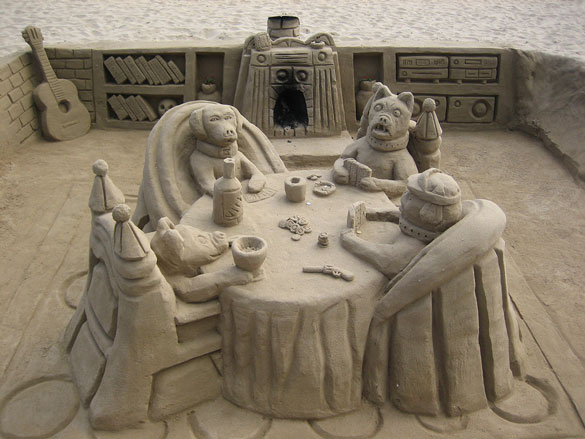
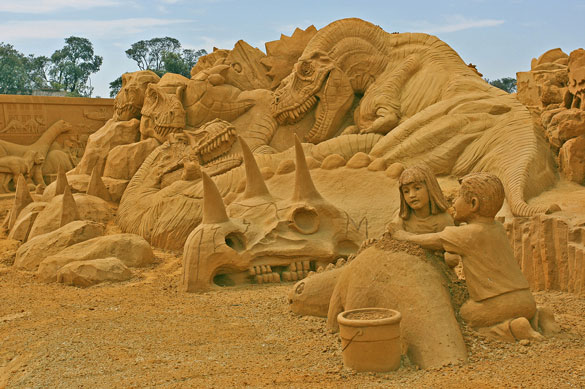
>>look for cheap flights to Oregon
Sand painting
Religious sand art is present in many parts of Asia, particularly in Tibet. The sand mandala (from the Sanskrit mandala meaning essence, containing or circle circumference) is a colorful, almost kaleidoscopic circle designed by Buddhist monks and then filled in with sand using a series of funnels, bags and scrapers.
The mandalas are made of crushed sand or rock, though crushed lentils and other materials may be used. Mandalas are also present in Hinduism, where they may also be called Yantra. In both cases, mandalas contain religious symbols, and are not meant to be preserved. The making of the mandala is a form of worship by the person who makes it.
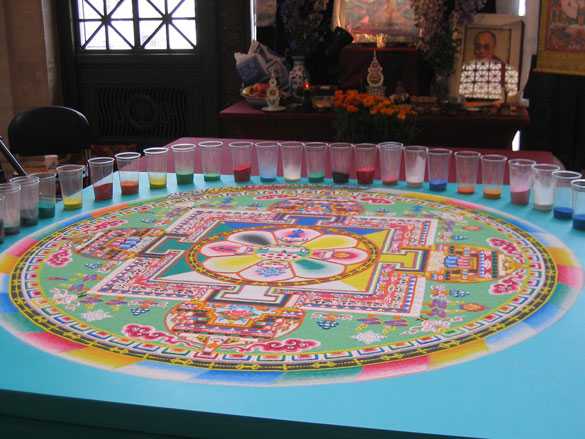

>>book Asia airfare
Ice Sculpture
Carving a giant block of ice into a recognizable glittering figure isn’t quite the same as standing on the beach under the hot sun, but it’s got that pop-culture element, and the results can be spectacular. Tools include a chain saw, drills with different bits, hand saws, picks and chippers, and of course, tongs. The usual uniform is somewhat unbecoming, with rubber boots and gloves being practically de rigueur. To buy your own ice carving supplies (including giant trays in which to freeze the ice blocks), follow that link.
For those of us who are less likely to hack at a piece of ice, and more likely to want to go see one, the winter festival in Quebec is a good option, or for the more intrepid, go to Harbin in northeastern China, where Siberia-like winter temperatures may drop to nearly 40 below. To see a more complete list of winter and snow festivals, click there. These competitions tend to take place in the winter, so plan on bundling up and heading out to see them in January or February.

>>look for flights to Quebec City
Butter sculpture
Moving away from the frozen-solid and towards something a little warmer, are the different types of butter sculpture. The oldest instance of butter sculpture is actually a Tibetan religious artform called Torma, in which butter is mixed with other ingredients, such as flour and colorful dyes either as ritual items or to later be consumed. The monks work the cold butter with their hands as though it were clay, and form it into various shapes of religious significance.
A more mass-market kind of butter sculpture consists of shaping a giant yellow cow out of “pure creamy Iowa butter,” over a frame of wood and wire mesh at the Iowa State Fair every August. The tradition is long-lasting, though the cow is not. The cow has been reproduced every year since 1910, and versions have cropped up in states as far-flung as New York. Other themes such as the Last Supper have also been created, though plans to build a model of Michael Jackson were thankfully, scrapped.
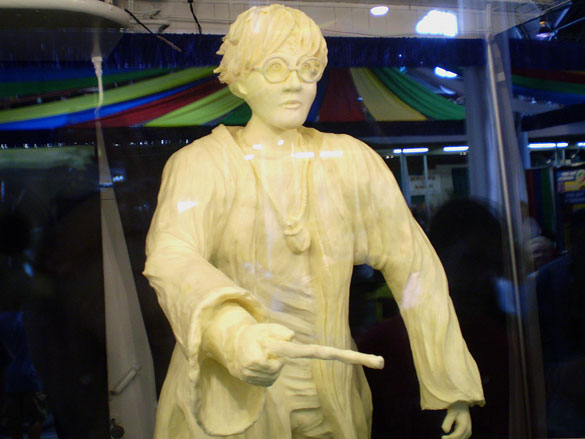

>>book New York airfare
Carved vegetables
Many of the garnishes that appear on your plate at a Japanese or Thai restaurant are truly works of art. If you’ve ever wondered how to make those tiny birds or clever radish roses, or even a giant carved watermelon where the red flesh is visible through the green rind, consider buying this book. The website also has links to different sets of peelers and carving tools you may need for your next play-with-your-food project.
But a better-known type of vegetable art can be seen mainly in late October, and mainly in the United States. Despite cold temperatures, the carved pumpkin (or Jack o’lantern) doesn’t usually stand much of chance of making it far into November, making it somewhat ephemeral as well.
Between neighborhood vandals, rot and the local fauna, these artworks are mainly best enjoyed on their shining night, which is Halloween, or October 31st. Impromptu parties abound, with children and adults hacking at pumpkins with slippery hands and old kitchen implements and seeded pumpkiny pulp stuck to nearly every available surface. To see a giant collection of carved pumpkins, join the crowds that pour into Keene, New Hampshire every year for their giant display at the Pumpkin Fest. They usually have more than 20,000 pumpkins, though they recently lost their most-carved-pumpkins crown to Camp Sunshine, a summer camp for sick children, which held its own Jack o’lantern contest in Boston in 2006. Tune in this year to see if Keene wins its title back on Saturday, October 17th. More details here.


>>look for a cheap flight to Boston
Flower carpets
Carpets are usually long lasting, at least until someone spills grape juice on them. These carpets are made of flowers and flower petals, or of colored sawdust, to cover large surfaces and be seen from a distance. One very large display of this sort is the Tapis de Fleurs in Brussels, Belguim, which will be premiered this year on August 12th at 9 AM.
The concept for the first flower carpet in Brussels was developed by E. Stautemans, a landscape architect whose projects have included a massive carpet at Ghent of 164 x 42 meters, but the foreground of the Grand Place in Brussels is his favored setting, and this 77 by 44 meter carpet is still huge and impressive. For more information, visit the Brussels flower carpet site here.
Other flower carpets are constructed around the world at Corpus Christi, a Catholic holiday that takes place in June. Carpets may be seen in areas as diverse as Tenerife in the Canary Islands, inside the Arundel Cathedral in Arundel, England, and of course in Rome. These carpets filled with religious symbols are meant to be admired, and at the end of the day, trodden upon, making them a truly short-lived affair.
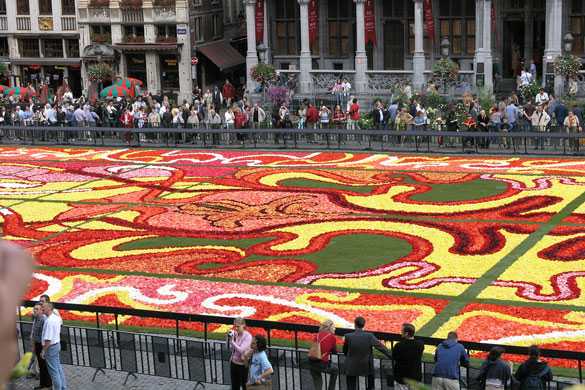
>>look for Brussels airfare
With so many continually changing works of art (or kitsch) to see in so many locations, there’s no reason to limit yourself to museums, canvases or mundane sculpture materials. There’s bound to be something decorated, painted, carved or cast somewhere near you. Tell us about it!
Read more about:
- The World’s Best Cities for Viewing Street Art
- Eight Paintings Every Traveler Should See (And Where to See Them)
- 9 of the Coolest Art Hotels in the World
- 15 of the Most Beautiful Subway Stops in the World
Photo credits:
Sand cats by ThisParticularGreg on Flickr, Dogs playing poker by kandinski on Flickr, Sand dinosaur by wikimedia, Sand painting by wikicommons, Ice sculpture by Today is a good day on Flickr, Butter Harry by jakebouma on Flickr, Butter cow by wikimedia, Watermelon by bluemodern on Flickr, JackOLanterns by anonymous to you on Flickr, Carpet by vdhaeyere on Flickr